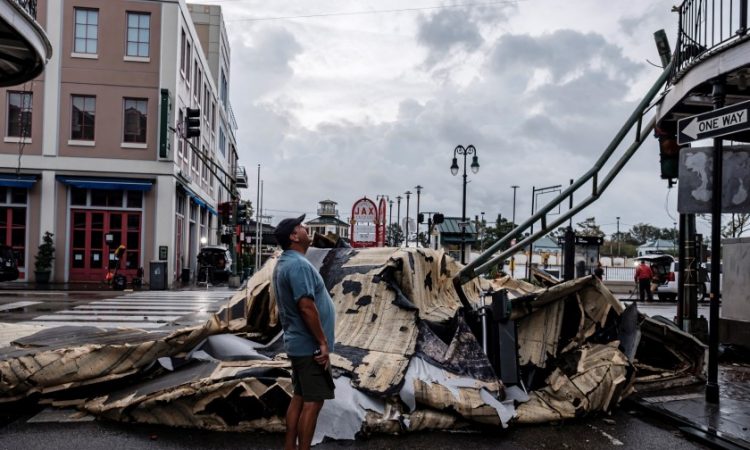
The rescue efforts and the recounting of the devastation caused this Sunday with the arrival in the US of the “catastrophic” Hurricane Ida, which left at least one dead in Louisiana, began this Monday amid the desolation and the cut of the supply electric, which affects more than a million customers and the entire city of New Orleans.
US President Joe Biden said today that Ida caused “massive damage” during a virtual meeting with the governors and mayors of the affected areas in which he announced that some 5,000 members of the National Guard had been displaced to the area. shocked.
Biden confirmed the death of a person by Ida, considered one of the most powerful hurricanes to make landfall in the country, and stressed that that number is likely to increase.
In the same vein, the governor of Louisiana, John Bel Edwards, said that the deaths could rise “considerably” and that the “catastrophic” impact of the cyclone supposes a long-term recovery.
Meanwhile, the first images show a terrible panorama with people in boats traveling through flooded streets, trees uprooted, downed power lines, destruction of homes, offices and hospitals, highway closures due to debris and landslides on embankments.
Ida, now a tropical storm, continues its destructive journey to the northern United States today, after making landfall on Sunday and causing the first fatality and significant damage to infrastructure in this southern US region of the Gulf of Mexico.
Despite its degradation, Ida still poses serious risks of tornadoes, destructive winds and flooding, either from heavy rains or also from storm surge, which threatens even coastal areas of Alabama and northwest Florida, according to the Center’s predictions. Hurricane National (NHC).
The Miami-based agency also warned that the impacted areas will include the southern US coast, the Tennessee Valley, central Appalachia and the northwest of the country through the middle of the week.
NEW ORLEANS, NIGHTMARE IN THE DARK
The city of New Orleans, which has not yet overcome the ghost of the deadly Katrina, which also made landfall in the area on August 29 16 years ago, is the most affected by the blackouts, which are feared could last for weeks.
Electric utility Entergy Louisiana, which serves more than a million customers in the state, announced “catastrophic transmission damage” on Sunday, affecting its eight transmission lines in New Orleans and is working around the clock to reactivate service. .
Some hospitals report that they have had to manually pump air into the lungs of COVID-19 patients in New Orleans, which for now depends on power generating plants and has also had problems with pumping drinking water due to lack of Of electricity.
In total, more than a million customers in Louisiana and another 97,000 in Mississippi continued today without power service, according to the specialized website Poweroutage.us.
Governor Edwards asked the community to stay in their homes while the damage is assessed, warning that it is dangerous to move through the affected areas.
NOLA Ready, the New Orleans emergency authority, asked those who evacuated not to return to their homes until new news is known due to the amount of debris that can be dangerous, as well as floods and blackouts.
The Red Cross established some 60 shelters, which have housed some 2,500 people.
The cyclone, however, was a test for the new retaining walls in the vicinity of the city, which could for now stop the water from Lake Pontchartrain and prevented a repeat of the Katrina nightmare that caused more than 1,800 deaths in the region, especially due to flooding after the break of the levee in 2005.
IDA, ONE OF THE MOST POWERFUL
Ida made landfall twice in an insular area of southern Louisiana with winds of 240 kilometers per hour (150 miles) and held for several hours with that power of category 4 on the Saffir-Simpson scale, out of a total of 5, discharging heavy rains that have left severe flooding.
Images of residents of LaPlace, also in Louisiana, showed people moving in small boats through flooded streets on Monday.
On Sunday, even the course of the Mississippi River changed its course at times due to the forces of the storm surge that pushed the stream in the opposite direction.
The Mississippi “literally” momentarily changed course, President Biden said today, referring to the power of Ida.
At least 2,400 personnel from the Federal Emergency Management Agency (FEMA) were deployed in the region, in addition to 12 search and rescue teams and a hundred ambulances.
Governor Edwards reported Ida’s first fatality on Sunday: a 60-year-old man who died after being injured by a falling tree in Ascencion, another Louisiana county, in the metropolitan area of Baton Rouge, the state capital. .
Ida made landfall around noon Sunday at Port Fourchon, an oil port in the southern tip of Louisiana, and then made landfall again very close to there, at Galliano.
According to meteorologists’ measurements, Ida, considered by Governor Edwards to be one of the most powerful cyclones to make landfall in US history, had winds exceeding 170 miles per hour.
Storm Ida was found today at 2:00 p.m. EST (18:00 GMT) about 40 miles southwest of Jackson (Mississippi), according to the NHC, an agency that also reported the new Tropical Storm Kate in the Atlantic and that for now has not poses a risk on land.
From Listín Diario







